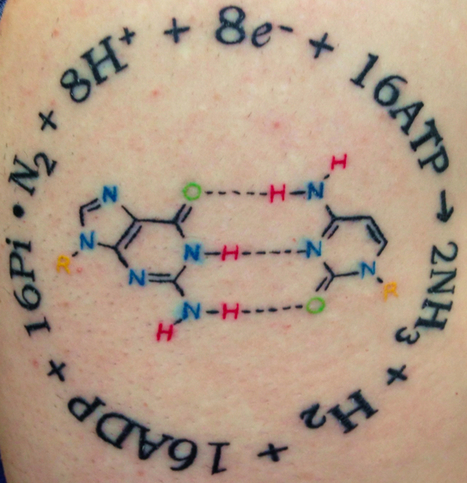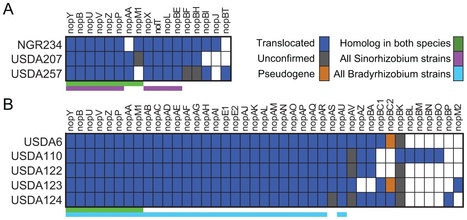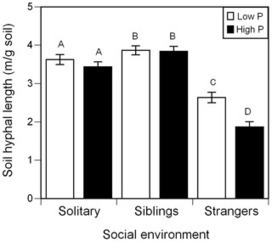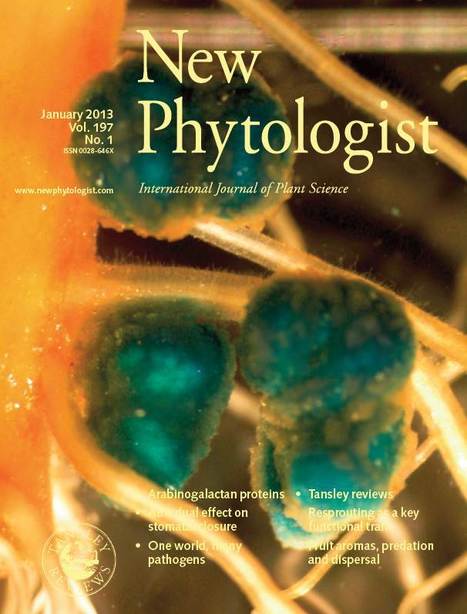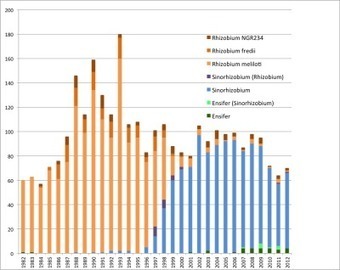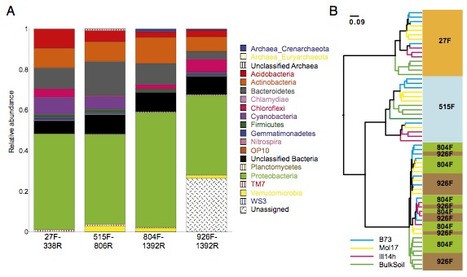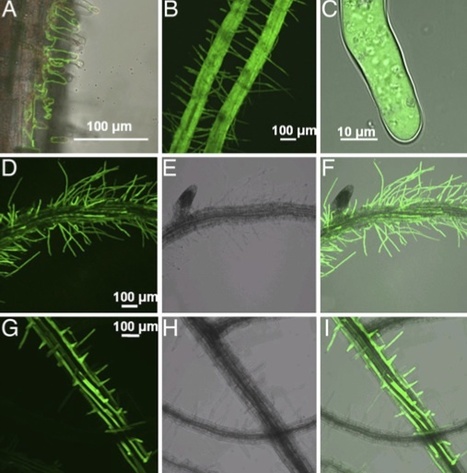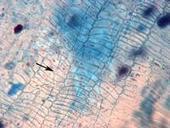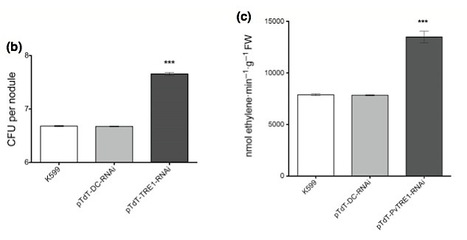 Your new post is loading...
 Your new post is loading...
Medicago truncatula or barrel medic is native to the Mediterranean. It is a member of the legume family of flowering plants. More famous members of the family include pea, soybean, beans, peanuts a...
If we don’t watch out, agriculture could destroy our planet. Here’s how to grow all the food we need with fewer chemicals.
The 22th North American Conference on Symbiotic Nitrogen Fixation will commence on July 14, 2013 with an opening reception from 6:30-9:30 PM in the Cowles Auditorium at the Hubert Humphrey Conference Center at the University of Minnesota. The conference consists of three days of plenary sessions and poster presentations. The topics for the conference sessions are in the following areas: Nodule Development PhysiologyEvolution of Symbioses Bacterial Endophytes Agricultural Applications Physiology and Genetics of BacteriaPhysiology Genetics of the Legume Host Genomic Approaches to Understanding Symbioses Organizing Committee Mike Sadowsky, University of Minnesota Ford Denison, University of Minnesota Carroll Vance, University of Minnesota
Via IvanOresnik
Jason Affourtit writes, “The encircling equation represents biological nitrogen fixation, which was at the core of my undergrad/graduate … (RT @carlzimmer: Pulling life out of thin air: a tattoo of nitrogen fixation.
Symbiotic associations between leguminous plants and nitrogen-fixing rhizobia culminate in the formation of specialized organs called root nodules, in which the rhizobia fix atmospheric nitrogen and transfer it to the plant. Efficient biological nitrogen fixation depends on metabolites produced by and exchanged between both partners. The Medicago truncatula–Sinorhizobium meliloti association is an excellent model for dissecting this nitrogen-fixing symbiosis because of the availability of genetic information in both symbiotic partners. Here, we employed a powerful imaging technique, matrix-assisted laser desorption/ionization (MALDI)-mass spectrometric imaging (MSI), to study metabolite distribution in roots and root nodules of M. truncatula during nitrogen fixation. The combination of an efficient, novel MALDI matrix 1,8-bis(dimethyl-amino) naphthalene (DMAN) with a conventional matrix 2,5-dihydroxybenzoic acid (DHB) allowed the detection of a large array of organic acids, amino acids, sugars, lipids, flavonoids and their conjugates with improved coverage. Ion density maps of representative metabolites are presented and correlated with the nitrogen fixation process. We demonstrate differences in metabolite distribution between roots and nodules, and also between fixing and non-fixing nodules produced by plant and bacterial mutants. Our study highlights the benefits of using MSI for detecting differences in metabolite distributions in plant biology. Ye VH, Gemperline E, Venkateshwaran M, Chen R, Delaux PM, Howes-Podoll M, Ané JM, Li L.(2013).Plant J. Mar 30. doi: 10.1111/tpj.12191. [Epub ahead of print]
Via IvanOresnik
The interaction of legumes with N2-fixing bacteria collectively called rhizobia results in root nodule development. The number of nodules formed is tightly restricted through the systemic negative feedback control by the host called autoregulation of nodulation (AON). Here, we report the characterization and gene identification of TOO MUCH LOVE (TML), a root factor that acts during AON in a model legume Lotus japonicus. In our genetic analyses using another root-regulated hypernodulation mutant,plenty, the tml-1 plenty double mutant showed additive effects on the nodule number, whereas the tml-1 har1-7 double mutant did not, suggesting that TML and PLENTY act in different genetic pathways and that TML and HAR1 act in the same genetic pathway. The systemic suppression of nodule formation by CLE-RS1/RS2 overexpression was not observed in the tml mutant background, indicating that TML acts downstream of CLE-RS1/RS2. The tml-1 Snf2 double mutant developed an excessive number of spontaneous nodules, indicating that TML inhibits nodule organogenesis. Together with the determination of the deleted regions in tml-1/-2/-3, the fine mapping of tml-4 and the next-generation sequencing analysis, we identified a nonsense mutation in the Kelch repeat-containing F-box protein. As the gene knockdown of the candidate drastically increased the number of nodules, we concluded that it should be the causative gene. An expression analysis revealed that TMLis a root-specific gene. In addition, the activity of ProTML-GUS was constitutively detected in the root tip and in the nodules/nodule primordia upon rhizobial infection. In conclusion, TML is a root factor acting at the final stage of AON.
The arbuscular mycorrhizal (AM) symbiosis is widespread throughout the plant kingdom and important for plant nutrition and ecosystem functioning. Nonetheless, most terrestrial ecosystems also contain a considerable number of non-mycorrhizal plants. The interaction of such non-host plants with AM fungi (AMF) is still poorly understood. Here, in three complementary experiments, we investigated whether the non-mycorrhizal plant Arabidopsis thaliana, the model organism for plant molecular biology and genetics, interacts with AMF. We grewA. thaliana alone or together with a mycorrhizal host species (either Trifolium pratense or Lolium multiflorum), in the presence or absence of the AMF Rhizophagus irregularis. Plants were grown in a dual-compartment system with a hyphal mesh separating roots of A. thalianafrom roots of the host species, avoiding direct root competition. The host plants in the system ensured the presence of an active AM fungal network. Arbuscular mycorrhizal fungal networks caused growth depressions in A. thaliana of more than 50%, which were not observed in the absence of host plants. Microscopy analyses revealed that R. irregularis supported by a host plant was capable of infecting A. thalianaroot tissues (up to 43% of root length colonized), but no arbuscules were observed. The results reveal high susceptibility of A. thaliana toR. irregularis, suggesting that A. thaliana is a suitable model plant to study non-host/AMF interactions and the biological basis of AM incompatibility.
Two diametric paradigms have been proposed to model the molecular co-evolution of microbial mutualists and their eukaryotic hosts. In one, mutualist and host exhibit an antagonistic arms race and each partner evolves rapidly to maximize their own fitness from the interaction at potential expense of the other. In the opposing model, conflicts between mutualist and host are largely resolved and the interaction is characterized by evolutionary stasis. We tested these opposing frameworks in two lineages of mutualistic rhizobia,Sinorhizobium fredii and Bradyrhizobium japonicum. To examine genes demonstrably important for host-interactions we coupled the mining of genome sequences to a comprehensive functional screen for type III effector genes, which are necessary for many Gram-negative pathogens to infect their hosts. We demonstrate that the rhizobial type III effector genes exhibit a surprisingly high degree of conservation in content and sequence that is in contrast to those of a well characterized plant pathogenic species. This type III effector gene conservation is particularly striking in the context of the relatively high genome-wide diversity of rhizobia. The evolution of rhizobial type III effectors is inconsistent with the molecular arms race paradigm. Instead, our results reveal that these loci are relatively static in rhizobial lineages and suggest that fitness conflicts between rhizobia mutualists and their host plants have been largely resolved.
Via Kamoun Lab @ TSL
Symbiotic nitrogen fixation by rhizobia in legume root nodules injects approximately 40 million tonnes of nitrogen into agricultural systems each year. In exchange for reduced nitrogen from the bacteria, the plant provides rhizobia with reduced carbon and all the essential nutrients required for bacterial metabolism. Symbiotic nitrogen fixation requires exquisite integration of plant and bacterial metabolism. Central to this integration are transporters of both the plant and the rhizobia, which transfer elements and compounds across various plant membranes and the two bacterial membranes. Here we review current knowledge of legume and rhizobial transport and metabolism as they relate to symbiotic nitrogen fixation. Although all legume-rhizobia symbioses have many metabolic features in common, there are also interesting differences between them, which show that evolution has solved metabolic problems in different ways to achieve effective symbiosis in different systems. Michael Udvardi and Philip S. Poole (2013). Annual Review of Plant Biology 64: first posted online March 1.
Via IvanOresnik
Beneficial associations between plants and arbuscular mycorrhizal fungi play a major role in terrestrial environments and in the sustainability of agroecosystems. Proteins, microRNAs, and small molecules have been identified in model angiosperms as required for the establishment of arbuscular mycorrhizal associations and define a symbiotic ‘toolkit’ used for other interactions such as the rhizobia–legume symbiosis. Based on recent studies, we propose an evolutionary framework for this toolkit. Some components appeared recently in angiosperms, whereas others are highly conserved even in land plants unable to form arbuscular mycorrhizal associations. The exciting finding that some components pre-date the appearance of arbuscular mycorrhizal fungi suggests the existence of unknown roles for this toolkit and even the possibility of symbiotic associations in charophyte green algae.
Background: The stability of cooperative interactions among different species can be compromised by cheating. In the plant-mycorrhizal fungi symbiosis, a single mycorrhizal network may interact with many plants, providing the opportunity for individual plants to cheat by obtaining nutrients from the fungi without donating carbon. Here we determine whether kin selection may favour plant investment in the mycorrhizal network, reducing the incentive to cheat when relatives interact with a single network.Methodology/Principal Findings: We show that mycorrhizal network size and root colonization were greater when Ambrosia artemisiifolia L. was grown with siblings compared to strangers. Soil fungal abundance was positively correlated with group leaf nitrogen, and increased root colonization was associated with a reduced number of pathogen-induced root lesions, indicating greater benefit to plants grown with siblings.Conclusions/Significance: Plants can benefit their relatives through investment in mycorrhizal fungi, and kin selection in plants could promote the persistence of the mycorrhizal symbiosis.
The expression of the promoter of the trehalase gene PvTRE1 fused to GUS is restricted to nodules in Phaseolus vulgaris. Courtesy of Aarón Barraza & Federico Sánchez.
Via Kamoun Lab @ TSL
There are many publications on the bacteria that most people know as Sinorhizobium meliloti, S. fredii, and related species. The name of their genus has changed over the years, and I used Web of Science to track the ...
Via IvanOresnik
|
Bradyrhizobium japonicum was described from soybean root-nodule bacterial isolates. Since its description, several studies have revealed heterogeneities among rhizobia assigned to this species. Strains assigned to B. japonicum Group Ia have been isolated in several countries, and many of them are outstanding soybean symbionts used in inoculants worldwide, but they have also been isolated from other legume hosts. Here we summarize published studies indicating that Group Ia strains are different from B. japonicum type strain USDA 6T and its closely related strains, and present new morpho-physiological, genotypic and genomic evidences to support their reclassification into a novel species for which the name Bradyrhizobium diazoefficiens sp. nov. is proposed. The type strain of the novel species is the well-studied USDA 110T strain (=IAM 13628, =CCRC 13528, =NRRL B-4361, =IFO 14792, =TAL 102T, =BCRC 13528, =JCM 10833, =TISTR 339T, =SEMIA 5032T, =3I1B110, =ACCC 15034, =CCT 4249, =NBRC 14792, =NRRL B-4450, =R-12974, CNPSo 46T).
A parallel world of pseudo-academia, with prestigiously titled conferences and journals that will print seemingly anything for a fee, has the scientific community alarmed.
The rhizosphere is a critical interface supporting the exchange of resources between plants and their associated soil environment. Rhizosphere microbial diversity is influenced by the physical and chemical properties of the rhizosphere, some of which are determined by the genetics of the host plant. However, within a plant species, the impact of genetic variation on the composition of the microbiota is poorly understood. Here, we characterized the rhizosphere bacterial diversity of 27 modern maize inbreds possessing exceptional genetic diversity grown under field conditions. Randomized and replicated plots of the inbreds were planted in five field environments in three states, each with unique soils and management conditions. Using pyrosequencing of bacterial 16S rRNA genes, we observed substantial variation in bacterial richness, diversity, and relative abundances of taxa between bulk soil and the maize rhizosphere, as well as between fields. The rhizospheres from maize inbreds exhibited both a small but significant proportion of heritable variation in total bacterial diversity across fields, and substantially more heritable variation between replicates of the inbreds within each field. The results of this study should facilitate expanded studies to identify robust heritable plant–microbe interactions at the level of individual polymorphisms by genome wide association, so that plant-microbiome interactions can ultimately be incorporated into plant breeding.
Reactive oxygen species (ROS), particularly hydrogen peroxide (H2O2), play an important role in signalling in various cellular processes. The involvement of H2O2 in the Medicago truncatula–Sinorhizobium meliloti symbiotic interaction raises questions about its effect on gene expression. A transcriptome analysis was performed on inoculated roots of M. truncatula in which ROS production was inhibited with diphenylene iodonium (DPI). In total, 301 genes potentially regulated by ROS content were identified 2 d after inoculation. These genes includedMtSpk1, which encodes a putative protein kinase and is induced by exogenous H2O2 treatment. MtSpk1 gene expression was also induced by nodulation factor treatment. MtSpk1 transcription was observed in infected root hair cells, nodule primordia and the infection zone of mature nodules. Analysis with a fluorescent protein probe specific for H2O2 showed that MtSpk1 expression and H2O2 were similarly distributed in the nodule infection zone. Finally, the establishment of symbiosis was impaired by MtSpk1 downregulation with an artificial micro-RNA. Several genes regulated by H2O2 during the establishment of rhizobial symbiosis were identified. The involvement of MtSpk1 in the establishment of the symbiosis is proposed.
Nitrogen is quantitatively the most important nutrient that plants acquire from the soil. It is well established that plant roots take up nitrogen compounds of low molecular mass, including ammonium, nitrate, and amino acids. However, in the soil of natural ecosystems, nitrogen occurs predominantly as proteins. This complex organic form of nitrogen is considered to be not directly available to plants. We examined the long-held view that plants depend on specialized symbioses with fungi (mycorrhizas) to access soil protein and studied the woody heathland plant Hakea actites and the herbaceous model plant Arabidopsis thaliana, which do not form mycorrhizas. We show that both species can use protein as a nitrogen source for growth without assistance from other organisms. We identified two mechanisms by which roots access protein. Roots exude proteolytic enzymes that digest protein at the root surface and possibly in the apoplast of the root cortex. Intact protein also was taken up into root cells most likely via endocytosis. These findings change our view of the spectrum of nitrogen sources that plants can access and challenge the current paradigm that plants rely on microbes and soil fauna for the breakdown of organic matter.
Via Kamoun Lab @ TSL
Symbiotic nitrogen fixation by intracellular rhizobia within legume root nodules requires the exchange of nutrients between host plant cells and their resident bacteria. While exchanged molecules imply nitrogen compounds, carbohydrates and also various minerals, knowledge of the molecular basis of plant transporters that mediate those metabolite exchanges is still limited. In this study, we have shown that a multidrug and toxic compound extrusion (MATE) protein, LjMATE1, is specifically induced during nodule formation, which nearly paralleled nodule maturation, in a model legume Lotus japonicus. Reporter gene experiments indicated that the expression of LjMATE1 was restricted to the infection zone of nodules. To characterize the transport function of LjMATE1, we conducted a biochemical analysis using a heterologous expression system, Xenopus oocytes, and found that LjMATE1 is a specific transporter for citrate. The physiological role of LjMATE1 was analyzed after generation of L. japonicus RNA interference (RNAi) lines. One RNAi knock-down line revealed limited growth under nitrogen-deficient conditions with inoculation of rhizobia compared with the controls (the wild type and an RNAi line in which LjMATE1 was not suppressed). It was noteworthy that Fe localization was clearly altered in nodule tissues of the knock-down line. These results strongly suggest that LjMATE1 is a nodule-specific transporter that assists the translocation of Fe from the root to nodules by providing citrate.
Background. Sinorhizobium meliloti is a soil-dwelling alpha-proteobacterium that possesses a large, tripartite genome and engages in a nitrogen fixing symbiosis with its plant hosts. Although much is known about this important model organism, global characterization of genetic regulatory circuits has been hampered by a lack of information about transcription and promoters. Results. Using an RNAseq approach and RNA populations representing 16 different growth and stress conditions, we comprehensively mapped S. meliloti transcription start sites (TSS). Our work identified 17,001 TSS that we grouped into six categories based on the genomic context of their transcripts: mRNA (4,430 TSS assigned to 2,657 protein-coding genes), leaderless mRNAs (171), putative mRNAs (425), internal sense transcripts (7,650), antisense RNA (3,720), and trans-encoded sRNAs (605). We used this TSS information to identify transcription factor binding sites and putative promoter sequences recognized by seven of the 15 known S. meliloti sigma factors sigma70, sigma54, sigmaH1, sigmaH2, sigmaE1, sigmaE2, and sigmaE9). Altogether, we predicted 2,770 new promoter sequences, including 1,302 located upstream of protein coding genes and 722 located upstream of antisense RNA or trans-encoded sRNA genes. To validate promoter predictions for targets of the general stress response sigma factor, RpoE2 (sigmaE2), we identified rpoE2-dependent genes using microarrays and confirmed TSS for a subset of these by 5[prime] RACE mapping. Conclusions. By identifying TSS and promoters on a global scale, our work provides a firm foundation for the continued study of S. meliloti gene expression with relation to gene organization, sigma factors and other transcription factors, and regulatory RNAs. Jan-Philip Schlüter, Jan Reinkensmeier, Melanie J Barnett, Claus Lang, Elizaveta Krol, Robert Giegerich, Sharon R Long and Anke Becker (2013). BMC Genomics 14:156.
Via IvanOresnik
At the conference Forsythe's presentation entitled A Field Study of Specificity in the Arbuscular Mycorrhizal Symbiosis won the prestigious John L. Harley Medal for excellence. The John L. Harley Medal is awarded at each ...
Life demands tradeoffs, and plants are no exception. Virginia wildrye, common on U.S. prairies and rangelands, often plays host to a fungus that helps this grass grow. But the plant pays a price. Researchers have discovered that infected plants produce less pollen than their noninfected counterparts. Instead, the fungus causes the rye grass to make extra seeds, which transmit the fungus to the next generation and new locations. This is the first time a fungus has proven capable of manipulating plant reproduction. The finding highlights the complexity of the relationship between hosts and their guests.
University of Delaware
Janine Sherrier has been named the acting deputy dean for the University of ...
Legume–rhizobium interactions have been widely studied and characterized, and the disaccharide trehalose has been commonly detected during this symbiotic interaction. It has been proposed that trehalose content in nodules during this symbiotic interaction might be regulated by trehalase. In the present study, we assessed the role of trehalose accumulation by down-regulating trehalase in the nodules of common bean plants. We performed gene expression analysis for trehalase (PvTRE1) during nodule development. PvTRE1 was knocked down by RNA interference (RNAi) in transgenic nodules of the common bean. PvTRE1 expression in nodulated roots is mainly restricted to nodules. Down-regulation of PvTRE1 led to increased trehalose content (78%) and bacteroid number (almost one order of magnitude). In addition, nodule biomass, nitrogenase activity, and GOGAT transcript accumulation were significantly enhanced too. The trehalose accumulation, triggered by PvTRE1 down-regulation, led to a positive impact on the legume–rhizobium symbiotic interaction. This could contribute to the agronomical enhancement of symbiotic nitrogen fixation.
Via Kamoun Lab @ TSL
|
 Your new post is loading...
Your new post is loading...
 Your new post is loading...
Your new post is loading...










